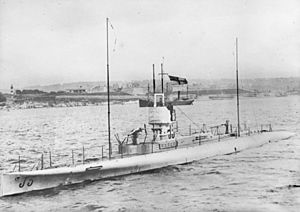HMS J5 facts for kids

HMAS J5 in 1919
|
|
Quick facts for kids History |
|
|---|---|
| Name | HMS J5 |
| Builder | HM Dockyard, Devonport |
| Launched | 9 September 1915 |
| Commissioned | 6 May 1916 |
| Fate | Transferred to Australia, 25 March 1919 |
| History | |
| Name | HMAS J5 |
| Acquired | 25 March 1919 |
| Decommissioned | 12 July 1922 |
| Fate | Sunk 4 June 1926 |
| General characteristics | |
| Class and type | British J class submarine |
| Displacement |
|
| Length | 275 ft (84 m) |
| Beam | 22 ft (6.7 m) |
| Draught | 14 ft (4.3 m) |
| Propulsion |
|
| Speed |
|
| Range | 4,000 nmi (7,400 km; 4,600 mi) at 12 kn (22 km/h; 14 mph) |
| Test depth | 300 ft (91 m) max |
| Complement | 44 personnel |
| Armament |
|
HMS J5 was a submarine that served during World War I. It was first part of the Royal Navy (British Navy) and later joined the Royal Australian Navy. It was one of the special J-class submarines.
Contents
About the J5 Submarine
Building a Fast Submarine
The Royal Navy designed the J-class submarines to be very fast. They wanted to match or beat German submarines that could travel over 18 knots (about 33 km/h) on the surface.
J5 was a large submarine for its time. It weighed 1,210 tons when on the surface and 1,820 tons when underwater. It was about 275 feet (84 meters) long, 22 feet (6.7 meters) wide, and sat 14 feet (4.3 meters) deep in the water.
These submarines were unique because they had three propellers. They used three powerful diesel engines to move on the surface. When underwater, they switched to electric motors powered by batteries.
J5 could travel at 19 knots (35 km/h) on the surface, making it one of the fastest submarines in the world back then. Underwater, its top speed was 9.5 knots (17.6 km/h). It could travel about 4,000 nautical miles (7,400 km) at a speed of 12 knots.
Weapons and Crew
The submarine was armed with six torpedo tubes, which fired 18-inch (450 mm) torpedoes. Four tubes were at the front, and one was on each side.
It also had a 4-inch (100 mm) gun on its deck. This gun was first placed near the command tower, but it was later moved to the front of the tower for better streamlining. A crew of 44 people operated the submarine.
J5 was built for the Royal Navy at HM Dockyard in Devonport, England. It was launched into the water on September 9, 1915, and officially started service on May 6, 1916.
World War I Service
J5 was part of the 11th Submarine Flotilla during World War I. It mostly operated in the North Sea, looking for German destroyers and U-boats (German submarines).
Even though J5 had several encounters with enemy ships, it never managed to sink one. The closest it came was hitting a German submarine called U-86 with a torpedo, but the torpedo did not explode.
After World War I, the British Navy decided to give six J-class submarines to the Royal Australian Navy (RAN). This was to help protect the Pacific region.
J5 and its sister submarines became part of the RAN in April 1919. They sailed to Australia on April 9, along with two cruisers, Sydney and Brisbane, and a support ship, Platypus.
During the long journey, J5 broke down while crossing the Red Sea. The cruiser Brisbane had to tow it for the rest of the trip. The group of ships arrived in Thursday Island on June 29 and in Sydney on July 10.
Because the submarines were in poor condition after the long voyage, they were immediately taken out of service for repairs.
Limited Use and Decommissioning
After their repairs, the submarines were not used very much. They took part in some local training exercises and visited Tasmania in 1921.
By June 1922, it became too expensive to keep the submarines running. Also, the economy was not doing well. So, all six J-class submarines were taken out of service and prepared for disposal.
Final Resting Place
J5 was officially taken out of service on July 12, 1922. It was sold on February 26, 1924. After its useful parts were removed, J5, along with J1 and J2, were purposely sunk.
They were scuttled (sunk on purpose) in a special area for old ships off Port Phillip Heads on June 4, 1926.
The wreck of J5 now lies in 39 meters (128 feet) of water at 38°09′S 144°52′E / 38.150°S 144.867°E. Experienced divers can visit the wreck.

